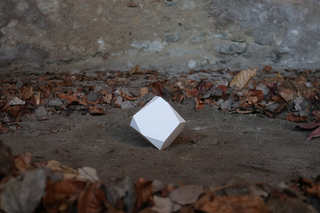Something moves but doesn't move
Umberto Cavenago presents a small work that is the quintessence of a paradox.
A paradox of glacial origin revisited by calculating reason. Able to return the intersection between the moment of intuition and scientific planning, Cavenago prepares a minimal intervention, focusing attention on an element with a geometric character, almost playful and luminous in the way it appears inside the space.
The small destabilized polyhedron, which is the result of a rewriting of a truncated hexedron with irregular faces that cancel out all the angles at 90 degrees, with a reference to a natural element with a mysterious motif: the erratic boulder.
By definition, an erratic boulder is a boulder (of varying size and many are known) that is not immobile, at least for human eyes and times. In fact, it has a very slow, indefinite geological cadence; its condition, almost philosophical, is that of infinitesimal displacement.
Cavenago thus imagines a shape drawn by chance, and builds by reference, a tetracaidecahedron, a solid archimedean with numerous faces and edges born from a regular polyhedron ready to move and support on the horizontal plane, a shape linked to the accidentality of wandering. It is placed on the ground, in a circular space obtained by the displacement of the dry leaves, as if to recall a void given by a possible impact (it was believed that the erratic boulders came from the sky, from the stars, like stones thrown by the gods). In Erratico accidentale rationality and causality meet.
Luca Scarabelli




Social
Contatti
umberto@cavenago.info